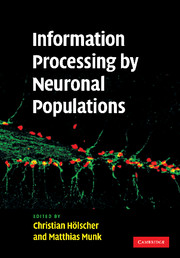Book contents
- Frontmatter
- Contents
- List of contributors
- Part I Introduction
- Part II Organization of neuronal activity in neuronal populations
- 2 Cellular mechanisms underlying network synchrony in the medial temporal lobe
- 3 Cell assemblies and serial computation in neural circuits
- 4 Neural population recording in behaving animals: constituents of a neural code for behavioral decisions
- 5 Measuring distributed properties of neural representations beyond the decoding of local variables: implications for cognition
- 6 Single-neuron and ensemble contributions to decoding simultaneously recorded spike trains
- Part III Neuronal population information coding and plasticity in specific brain areas
- Part IV Functional integration of different brain areas in information processing and plasticity
- Part V Disturbances of population activity as the basis of schizophrenia
- Part VI Summary, conclusion, and future targets
- Index
- References
5 - Measuring distributed properties of neural representations beyond the decoding of local variables: implications for cognition
Published online by Cambridge University Press: 14 August 2009
- Frontmatter
- Contents
- List of contributors
- Part I Introduction
- Part II Organization of neuronal activity in neuronal populations
- 2 Cellular mechanisms underlying network synchrony in the medial temporal lobe
- 3 Cell assemblies and serial computation in neural circuits
- 4 Neural population recording in behaving animals: constituents of a neural code for behavioral decisions
- 5 Measuring distributed properties of neural representations beyond the decoding of local variables: implications for cognition
- 6 Single-neuron and ensemble contributions to decoding simultaneously recorded spike trains
- Part III Neuronal population information coding and plasticity in specific brain areas
- Part IV Functional integration of different brain areas in information processing and plasticity
- Part V Disturbances of population activity as the basis of schizophrenia
- Part VI Summary, conclusion, and future targets
- Index
- References
Summary
Introduction
Neural representations are distributed. This means that more information can be gleaned from neural ensembles than from single cells. Modern recording technology allows the simultaneous recording of large neural ensembles (of more than 100 cells simultaneously) from awake behaving animals. Historically, the principal means of analyzing representations encoded within large ensembles has been to measure the immediate accuracy of the encoding of behavioral variables (“reconstruction”). In this chapter, we will argue that measuring immediate reconstruction only touches the surface of what can be gleaned from these ensembles. We will discuss the implications of distributed representation, in particular, the usefulness of measuring self-consistency of the representation within neural ensembles. Because representations are distributed, neurons in a population can agree or disagree on the value being represented. Measuring the extent to which a firing pattern matches expectations can provide an accurate assessment of the self-consistency of a representation. Dynamic changes in the self-consistency of a representation are potentially indicative of cognitive processes. We will also discuss the implications of representation of non-local (non-immediate) values for cognitive processes. Because cognition occurs at fast timescales, changes must be detectable at fast (millisecond, tens of milliseconds) timescales.
Representation
As an animal interacts with the world, it encounters various problems for which it must find a solution. The description of the world and the problems encountered within it play a fundamental role in how an animal behaves and finds a solution.
- Type
- Chapter
- Information
- Information Processing by Neuronal Populations , pp. 95 - 119Publisher: Cambridge University PressPrint publication year: 2008
References
- 8
- Cited by

